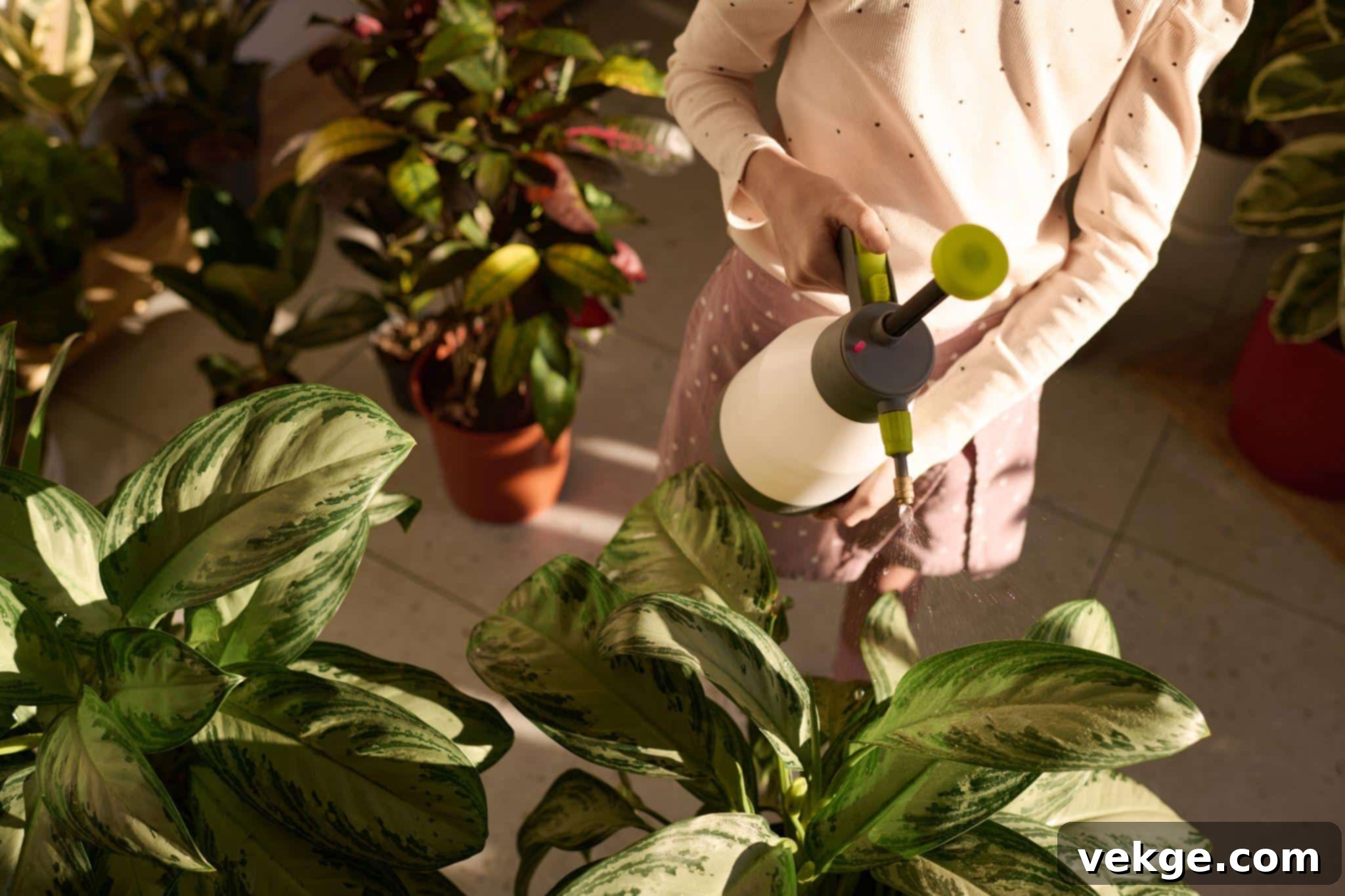Mastering Houseplant Humidity: A Comprehensive Guide for Thriving Indoor Plants
Indoor plants are more than just decorative accents; they are living elements that purify the air, boost mood, and bring a touch of nature indoors. However, for many plant enthusiasts, maintaining a healthy indoor garden presents a unique challenge: managing humidity levels. While your plants might receive adequate light and water, incorrect humidity can silently sabotage their health, leading to wilting leaves, stunted growth, and even susceptibility to pests and diseases.
The vast majority of popular houseplants, such as ferns, orchids, and various tropical foliage plants, originate from rainforests and other humid climates. In their natural habitats, the air is consistently laden with moisture, a stark contrast to the often dry conditions found in our homes, especially during colder months when heating systems are in use. Understanding and actively managing the humidity around your indoor plants is not just beneficial; it’s absolutely crucial for their long-term health and vibrant growth.
Why Optimal Humidity is Essential for Your Houseplants
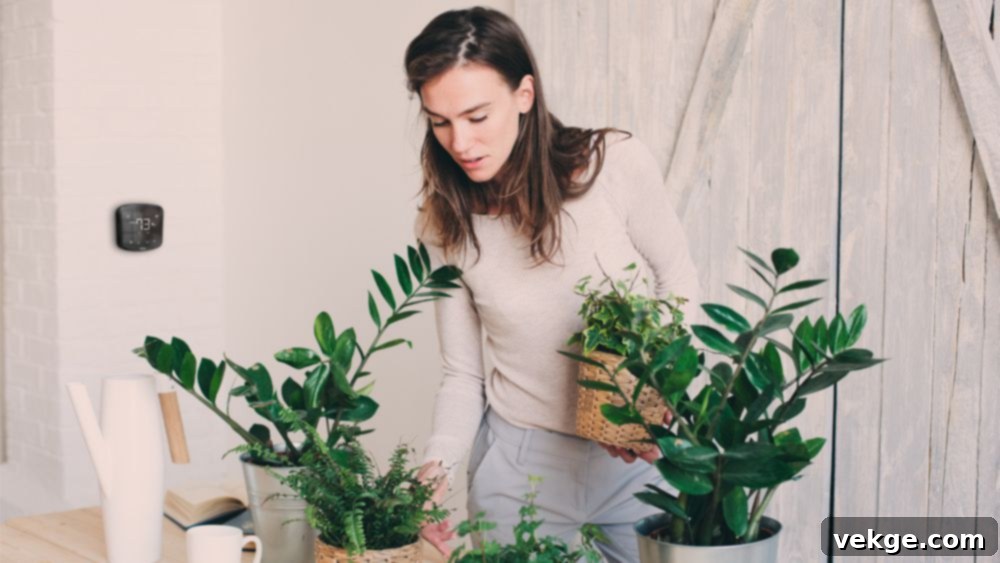
Humidity refers to the amount of water vapor present in the air. For plants, this environmental factor plays a pivotal role in several critical physiological processes, most notably transpiration. Transpiration is the process where plants release water vapor through tiny pores on their leaves called stomata. This process helps cool the plant and draws water and nutrients from the soil up through the roots, stems, and leaves.
In high humidity environments, plants transpire less, as there is already sufficient moisture in the air. This reduces water loss and helps prevent dehydration, keeping plant tissues firm and green. Conversely, when humidity is too low, plants transpire at an accelerated rate, losing water faster than their roots can absorb it. This can lead to severe water stress, making the plant struggle to maintain its internal moisture balance and nutrient uptake. For tropical plants, a lack of humidity can be as damaging as insufficient watering, manifesting in dry, brittle leaves and a generally unhealthy appearance.
Different plant species have varying humidity requirements. For instance, moisture-loving plants like ferns, calatheas, and many orchids thrive in environments with 60-80% humidity, reflecting their tropical origins. On the other hand, succulents, cacti, and other arid-adapted plants prefer much drier conditions, typically below 40%. Identifying the specific humidity needs of each plant in your collection is the foundational step toward effective humidity management and ensuring every plant flourishes.
Recognizing the Signs of Humidity Stress in Plants
Before implementing solutions, it’s vital to become adept at recognizing the symptoms of both low and high humidity stress in your houseplants. Early detection allows for timely intervention, preventing irreversible damage and promoting quicker recovery. Here are the common indicators:
Symptoms of Low Humidity:
- Brown and crispy leaf edges or tips: This is one of the most common and visible signs. The edges dry out first because water evaporates quickly from these areas.
- Leaf drop or wilting: Plants may drop older leaves to conserve moisture, or their leaves might wilt and appear limp, even if the soil is moist. This is a desperate attempt to reduce surface area for transpiration.
- Slow growth or stunted plants: Persistent low humidity can hinder a plant’s ability to photosynthesize efficiently and absorb nutrients, leading to noticeably slower growth or a complete halt in development.
- Curling leaves: Leaves may curl inwards or upwards, another protective mechanism to minimize moisture loss by reducing exposure to dry air.
- Bud blast in flowering plants: Flower buds may dry out and fall off before opening, especially common in orchids and gardenias.
Symptoms of High Humidity:
While less common in typical homes, excessively high humidity can also cause problems, particularly when combined with poor air circulation:
- Mold or mildew on the soil or plant leaves: A white, fuzzy growth indicates fungal issues, often exacerbated by stagnant, moist air.
- Fungal infections: High humidity creates ideal conditions for fungal spores to thrive, leading to various diseases like powdery mildew, black spot, or root rot (if soil stays too wet).
- Soft, rotting stems or leaves: Excessive moisture on leaves and stems, especially without air circulation, can lead to tissue breakdown and bacterial or fungal rot.
Being attentive to these signs will empower you to take prompt and appropriate action to adjust the humidity levels, ensuring your plants remain healthy and vibrant.
Top Tips and Tricks for Maintaining Optimal Humidity Levels
Achieving the perfect humidity balance for your diverse collection of indoor plants might seem daunting, but with a few tried-and-true methods, you can create a nurturing environment. Here are effective strategies to boost humidity for your houseplants:
1. Utilize a Humidity Tray (Pebble Tray)
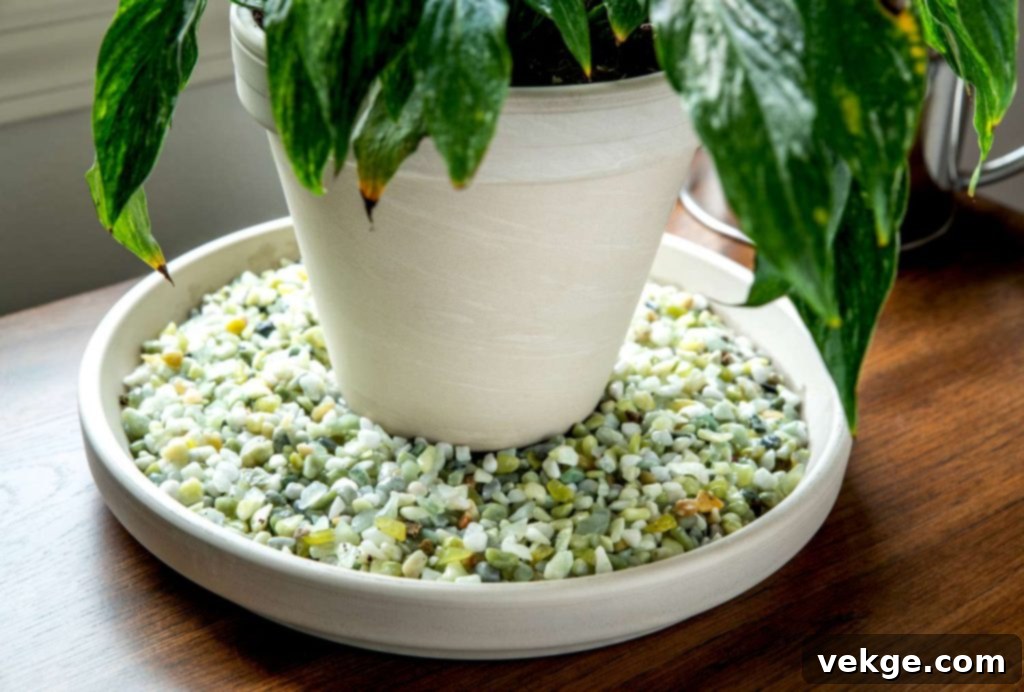
A simple yet highly effective method to locally increase humidity is using a pebble tray. Fill a shallow tray with water and then arrange a layer of pebbles or gravel on top. Place your plant pots directly on the pebbles, making sure the bottom of the pots are elevated above the water level. As the water slowly evaporates from the tray, it creates a localized pocket of increased humidity around the plant’s foliage. This method provides a consistent, gentle rise in moisture without oversaturating the plant’s roots. Remember to replenish the water regularly as it evaporates.
2. Group Plants Together
Harness the power of collective transpiration by grouping your humidity-loving plants. Plants naturally release moisture into the air as part of their transpiration process. When several plants are placed in close proximity, the combined moisture released by all of them creates a beneficial microenvironment with higher localized humidity. This natural clustering mimics their growth patterns in the wild and can significantly benefit plants in drier rooms. Just ensure there’s still enough air circulation between plants to prevent fungal issues.
3. Implement Regular Misting
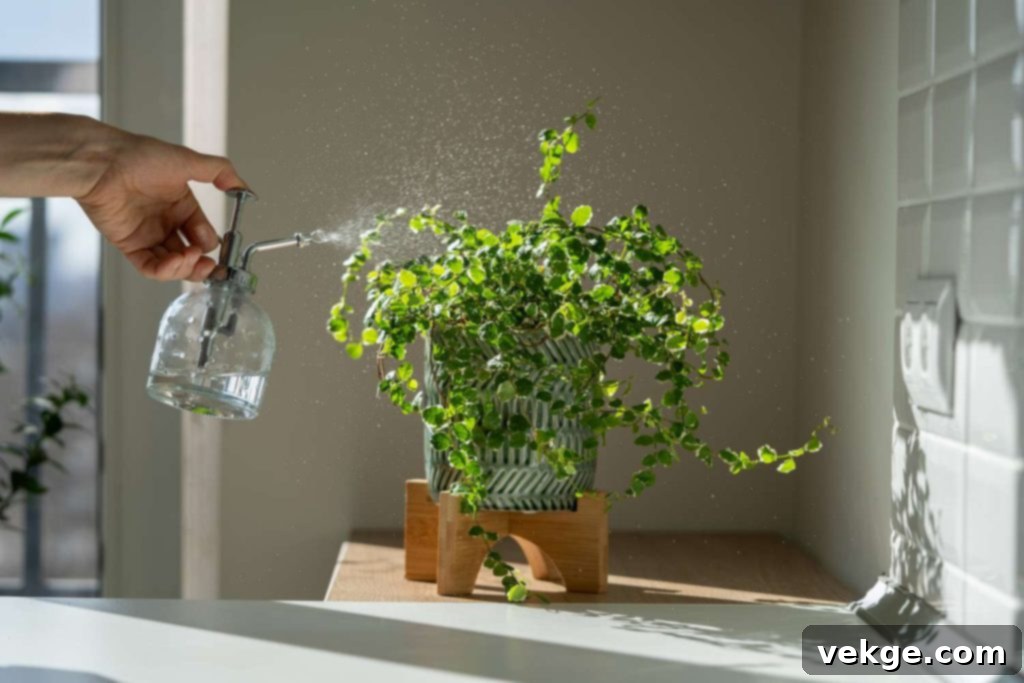
Misting involves lightly spraying the leaves of your plants with a fine mist of water. This technique provides an immediate, albeit temporary, boost in humidity around the plant. It’s particularly beneficial for plants that absorb moisture through their leaves, such as many epiphytic plants (e.g., some orchids and air plants). Use a clean spray bottle with distilled or filtered water to prevent mineral buildup on leaves. The best time to mist is in the morning, allowing the leaves ample time to dry before evening, which minimizes the risk of fungal growth. Avoid misting plants with fuzzy leaves, as water can get trapped and cause rot.
4. Invest in a Plant Humidifier
For more consistent and significant humidity control, especially in homes with very dry air (common during winter heating), a dedicated plant humidifier is an excellent investment. These devices release a fine mist of water into the air, effectively raising the ambient humidity throughout a room or a designated plant area. Look for cool-mist humidifiers, as they are safer and don’t raise room temperature. Position the humidifier close enough to your plants to be effective, but ensure it’s not blowing directly onto them, which can lead to over-saturation.
A highly recommended option for serious plant enthusiasts is the Spider Farmer Cool Mist Humidifier for Plants. This humidifier is specifically engineered with plant care in mind, featuring adjustable mist levels to cater to diverse plant needs, a large water tank for extended operation, and a convenient timer function for automated humidity control. Its efficient performance helps maintain optimal humidity, ensuring your plants receive the consistent moisture they need to truly thrive. Furthermore, its quiet operation ensures a peaceful home environment, and its sleek, modern design makes it a stylish addition to any plant setup or room decor.
If you’re ready to provide your plants with the ideal moist environment, you can click here to make a purchase and experience the difference.
5. Strategically Relocate Plants to Humid Areas
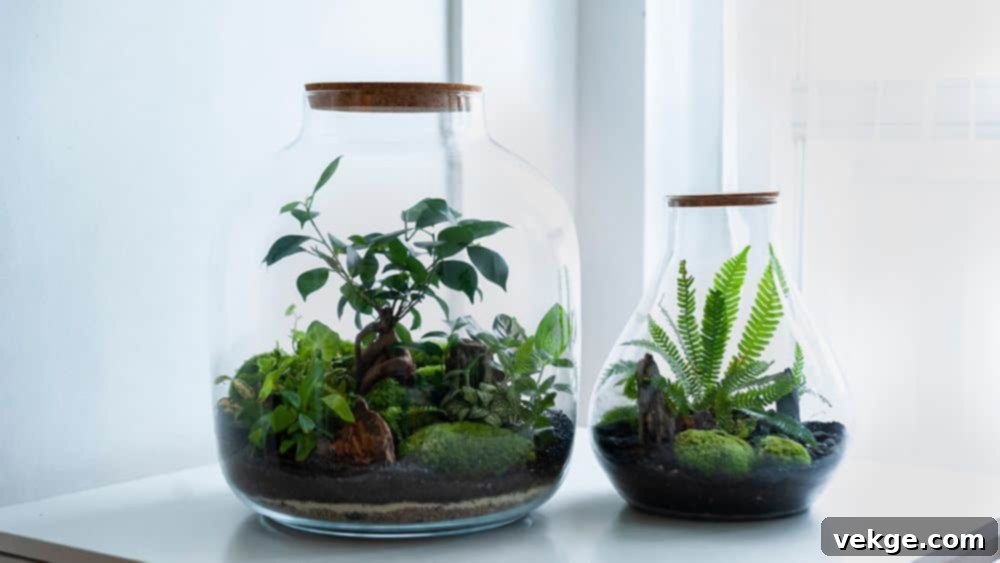
Certain areas in your home naturally experience higher humidity levels. Bathrooms and kitchens, for example, frequently have elevated moisture due to showers, baths, and cooking activities. Consider moving your most humidity-demanding plants, such as ferns, prayer plants, or peace lilies, to these rooms. Always ensure that they still receive adequate light, either from natural windows or by supplementing with artificial grow lights if necessary. This simple relocation can often provide a significant boost in ambient moisture.
6. Create a Temporary Mini Greenhouse with Plastic Covers
For a temporary, localized humidity boost, especially for new cuttings, seedlings, or plants recovering from stress, you can create a mini-greenhouse effect. Gently cover the plant and its pot with a clear plastic bag or dome. Ensure the plastic doesn’t touch the leaves directly, as this can trap too much moisture and cause rot. Leave a small opening at the bottom or top for some air circulation to prevent excessive condensation and mold growth. This method is particularly effective for propagation or for giving a struggling plant a temporary high-humidity environment to recover.
7. Monitor and Adjust with a Hygrometer
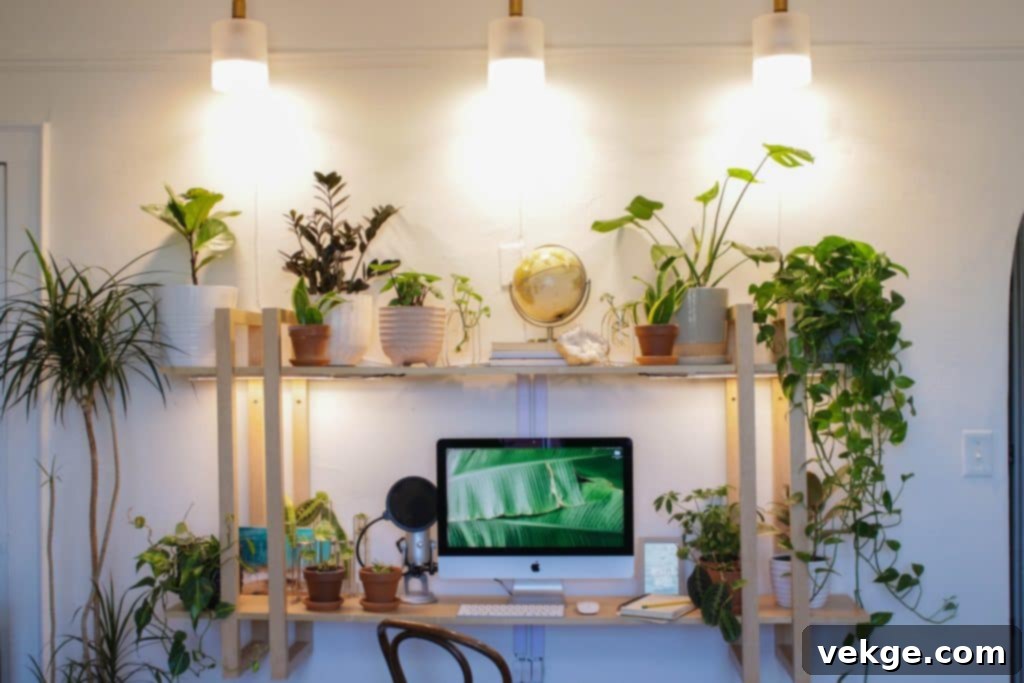
To accurately understand and manage your indoor environment, investing in a hygrometer is highly recommended. A hygrometer is an inexpensive and easy-to-use device that measures the relative humidity in the air. By regularly monitoring the readings, you can identify when humidity levels dip too low or climb too high and then make precise adjustments using the methods described above. Knowing the exact humidity level allows you to fine-tune your care routine, ensuring your plants are consistently in their ideal environment rather than relying on guesswork.
8. Construct a Humidity Tent or Terrarium
For plants that demand very high and consistent humidity, or for creating a specialized display, consider constructing a humidity tent or a closed terrarium. A humidity tent can be a large clear plastic bag or sheet draped over a group of plants and secured at the base. Terrariums, which are enclosed glass containers, create a self-sustaining humid microclimate. These options are perfect for extremely sensitive plants like certain fittonias or carnivorous plants. Regular ventilation (opening briefly) is essential for tents to prevent stagnant air and mold, while terrariums require careful balance to avoid excessive moisture.
9. Invest in Self-Watering Pots
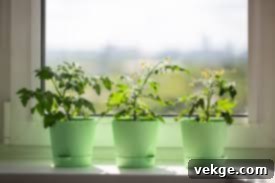
While primarily designed for watering, self-watering pots can indirectly contribute to better humidity management. These innovative pots typically have a reservoir at the bottom that provides a steady, consistent supply of water to the plant’s roots as needed. This constant moisture in the soil, even if not directly adding to atmospheric humidity, helps the plant maintain optimal turgor pressure and transpire more effectively without stressing. By reducing the chances of the plant drying out, it supports overall plant health, which in turn makes it more resilient to fluctuations in air humidity.
10. Avoid Overwatering to Prevent Related Low Humidity Issues
It might seem counterintuitive, but overwatering can actually exacerbate problems related to low humidity. When the soil is perpetually waterlogged, it suffocates the roots, leading to root rot. Damaged roots are unable to efficiently absorb water and nutrients, even if they are abundant in the soil. This impaired water uptake means the plant cannot adequately hydrate itself or transpire properly, causing it to exhibit symptoms similar to low humidity stress (e.g., wilting, browning leaves) even if ambient humidity is seemingly adequate. Always ensure your pots have good drainage and water your plants only when the topsoil is dry to the touch, according to their specific needs.
Conclusion
Mastering humidity levels is a fundamental, yet often overlooked, aspect of successful indoor plant care. By understanding the unique humidity requirements of your various houseplants and thoughtfully implementing these practical tips and tricks, you can create an environment where your indoor garden doesn’t just survive, but truly flourishes. Whether it’s through the simplicity of a pebble tray, the strategic grouping of plants, the precision of a humidifier, or the regular monitoring with a hygrometer, each strategy plays a vital role in maintaining optimal moisture balance. Remember, happy plants are vibrant plants, and a thriving indoor ecosystem contributes significantly to a happier, healthier home!
